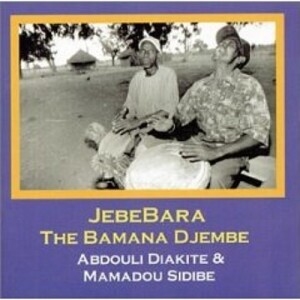 Big Earl Sellar wrote this review.
Big Earl Sellar wrote this review.
It’s always an embarrassing enterprise for me, reviewing audio discs. I mean, how does one convey in words the music of an artist? Or, in the case of these two, how do I write several paragraphs on a couple of hours of badabiddlebadathumpthump? Sometimes, I really have to shake my head at this endeavor.
So, yeah, we have some drumming discs here. Specifically we have some discs featuring the djembe, a large piece of tunable percussion that a player slaps barehanded, like a conga or bongo, and adjusts head tension by squeezing on the body, held between his knees. It’s a beautiful sounding instrument, and in the hands of a master, an incredibly versatile one. However, on its own, it’s still a drum, and after a while, one would really appreciate another instrument (even a differently toned drum) to accompany the sound.
Diakite is a professional drummer from Senegal, having spent 18 years drumming for the Ballet National du Senegal. Sidibe is a traditionalist, playing the djembe for his people, the Bamana of Mali. On JebeBara: The Bamana Djembe the two friends are reunited, recorded live in a village, running through some traditional patterns. Although there are some singers on some of the tracks, they’re so far afield from the microphones that one can barely hear them. So instead we hear mainly the drums. The drums are quite well recorded, with each subtle nuance in tone quite audible. Now, these guys are fantastic players, but if you’re not a drummer, this disc gets awfully tedious mighty fast. Perhaps if the singers were given more air time, giving some of this playing more context (since this appears to be a vocal/drum tradition), this disc would stand up better to repeated listening. Instead, well, it’s a lot of great drumming, and not much else.
Tambacounda Senegal has a much more interesting background. Sogoni is a traditional festival, design to educate the tribe (and especially the youngsters) about the various beasts they may encounter in the wild. In Tambacounda’s booklet, there are photographs from the festival, featuring dancers in elaborate animal costumes, rather like in Chinese dragon dances. However, the disc is more of the same: drumming, and lots of it. Again, one can barely discern singers (and what sounds like a clarinet) in the background; the djembe rules again. Only this is not as crisp a recording, so instead of crisp drums, we get muddy drums. One hour of bass thumping: just what the world needs to hear. As an ethnomusicological document, it has merit, but, again, if you don’t practice paradiddles on the bus, it might not be your cup of tea.
What we have here is something with a limited target audience. Well, if Micky Hart from the Grateful Dead can make a living from ethno-drumming records, I suppose others can try too. Rootsy Recordings appears to cater to those who really love listening to the djembe.
(Rootsy Records, 2001)
(Rootsy Records, 2001)
